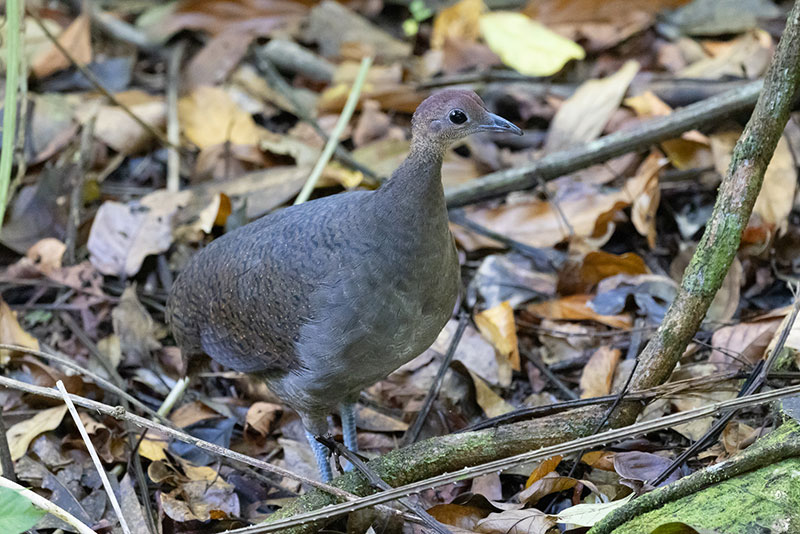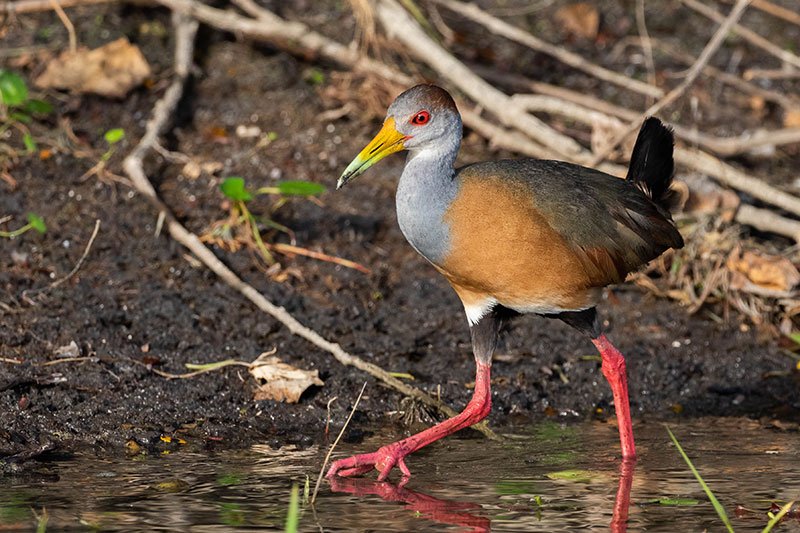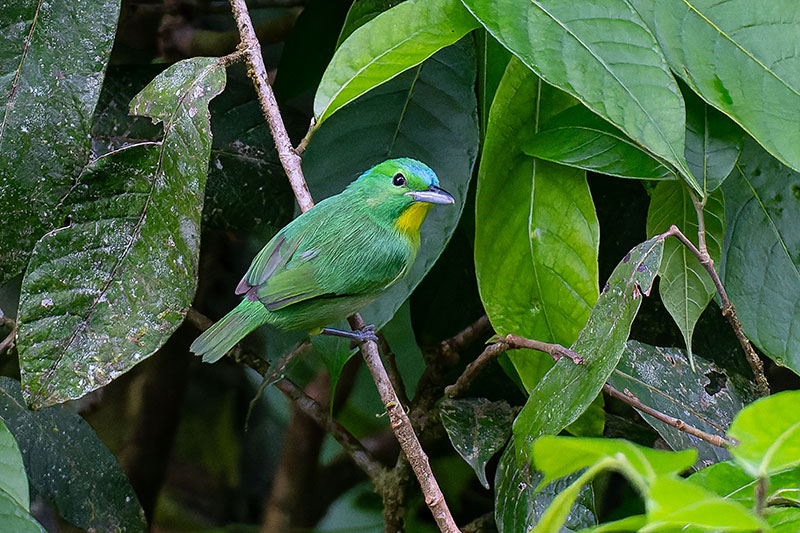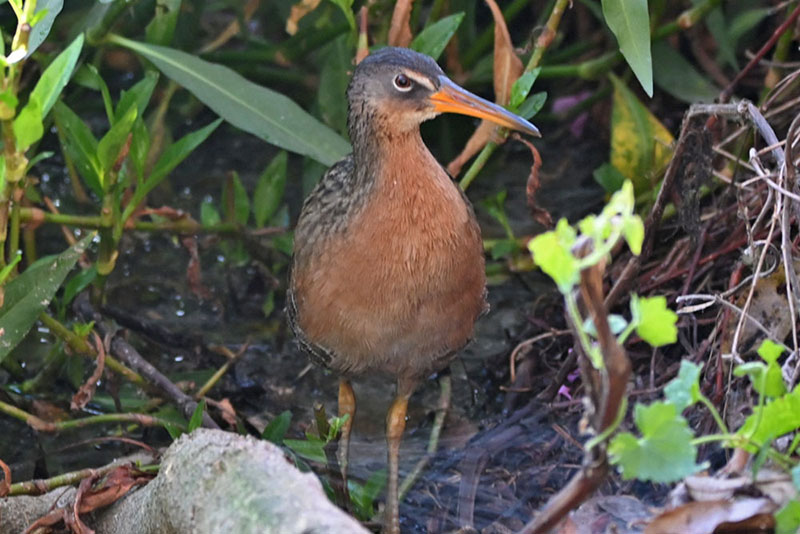Posts tagged with "Audio"

- 03 May, 2023
- Audio
Laughing Falcon (Herpetotheres cachinnans), HUAC-TLI2
“It sings in this manner: sometimes it laughs like some man; like a man speaking it can pronounce these words: yeccan, yeccan, yeccan. When it laughs, it says ha ha ha ha ha, ha hay, ha hay, hay hay, ay. Especially when it finds its food it really laughs" (FC, p. 42).
Audio recording by Adam Betuel. From the Macauley Library ML436679641.
Cf. page 65 in The Aztec Fascination with Birds monograph.
References Cited
Quoted material from the Florentine Codex (FC): Reprinted from Florentine Codex: General History of the Things of New Spain, Book 11, Earthly Things¸ by Fray Bernardino de Sahagún, translated by Arthur J.O. Anderson, and Charles E. Dibble with permission from School for American Research, Santa Fe, New Mexico. Copyright 1981.

- 03 May, 2023
- Audio, Photo
Great Tinamou (Tinamus major), IXMATLA-TŌTŌ-TL
“Its home is in the forest. It lives there in Anahuac . It is called ixmatlatototl because [its song] is almost like our own speech. When it sings, it says campa uee, as if it imitated those who live there …. Its bill is silvery. Its head, its breast, its back, its tail are completely ashen; its feet are ashen" (FC, p. 26).
Audio recording by Adam Dudley. From the Macauley Library ML432084251. Photo by Lukas Sekelsky.
Cf. pages 42–43 in The Aztec Fascination with Birds monograph.
References Cited
Quoted material from the Florentine Codex (FC): Reprinted from Florentine Codex: General History of the Things of New Spain, Book 11, Earthly Things¸ by Fray Bernardino de Sahagún, translated by Arthur J.O. Anderson, and Charles E. Dibble with permission from School for American Research, Santa Fe, New Mexico. Copyright 1981.

- 03 May, 2023
- Audio
Thicket Tinamou (Crypturellus cinnamomeus), TECUZIL-TŌTŌ-TL
“… it is so named [because] it always so speaks; it indeed pronounces [the sound] tecucilton, tecucilton. Its voice is thin. It is the same [size] as a quail, and its feathers are the same …. It lives in…[the provinces of] Teutlixco [and] Toztlan" (FC, p. 26).
Audio recording by Vicente Desjardins. From the Macauley Library ML435021671.
Cf. page 42 in The Aztec Fascination with Birds monograph.
References Cited
Quoted material from the Florentine Codex (FC): Reprinted from Florentine Codex: General History of the Things of New Spain, Book 11, Earthly Things¸ by Fray Bernardino de Sahagún, translated by Arthur J.O. Anderson, and Charles E. Dibble with permission from School for American Research, Santa Fe, New Mexico. Copyright 1981.

- 03 May, 2023
- Audio, Photo
Russet-naped Wood-Rail (Aramides castaneiventris), PŌPOCALES
“As for its being called popocales¸ it speaks so. Always in the twilight and at dawn, it says popocales…. it lives there in [the provinces of] Toztlan [and] Catemahco …. It is the size of a duck, only a little taller …. Its bill is pointed,…chili-red. Its eyes are chili-red. Its head is dark yellow. Its neck, its back, its breast, its tail are ashen….The legs are chili-red" (FC, p. 25–26).
Audio recording by Jessy Lopez Herra. From the Macaulay Library ML435824171. Photo by Alex Lamoreaux.
Cf. Figure 26 and pages 41–42 in The Aztec Fascination with Birds monograph.
References Cited
Quoted material from the Florentine Codex (FC): Reprinted from Florentine Codex: General History of the Things of New Spain, Book 11, Earthly Things¸ by Fray Bernardino de Sahagún, translated by Arthur J.O. Anderson, and Charles E. Dibble with permission from School for American Research, Santa Fe, New Mexico. Copyright 1981.

- 24 Apr, 2023
- Audio, Photo
Green Shrike-Vireo (Vireolanius pulchellus), TACHITOHUIYA
“It is small and green, small and round; a companion of the woodsman. It is named tachitouya because of its song, because its song says tachitouya. Whomever it sees, it comes along with him, singing as it goes; it goes along making [the sound] tachitouya” (FC, p. 46).
Audio recording by Daniel Garrigues. From the Macauley Library ML437064121. Photo by William Hemstrom.
Cf. page 73 in The Aztec Fascination with Birds monograph.
References Cited
Quoted material from the Florentine Codex (FC): Reprinted from Florentine Codex: General History of the Things of New Spain, Book 11, Earthly Things¸ by Fray Bernardino de Sahagún, translated by Arthur J.O. Anderson, and Charles E. Dibble with permission from School for American Research, Santa Fe, New Mexico. Copyright 1981.

- 24 Apr, 2023
- Audio
Curve-billed Thrasher (Toxostoma curvirostre), CUĪTLACOCH-IN/CUĪTLACOCH-TŌTŌ-TL
“It has a song, a varied song …. It is named cuitlacochtototl, which is taken from its song, because it says cuitlacoch, cuitlacoch, tarata, tarat, tatatati, tatatari, titiriti, tiriti…. It is capable of domestication; it is teachable….” (FC, p. 51).
Audio recording by Andrew Theus. From the Macauley Library ML436112051.
Cf. pages 79–80 in The Aztec Fascination with Birds monograph.
References Cited
Quoted material from the Florentine Codex (FC): Reprinted from Florentine Codex: General History of the Things of New Spain, Book 11, Earthly Things¸ by Fray Bernardino de Sahagún, translated by Arthur J.O. Anderson, and Charles E. Dibble with permission from School for American Research, Santa Fe, New Mexico. Copyright 1981.

- 24 Apr, 2023
- Audio
Canyon Wren (Catherpes mexicanus), TLATHUICICI-TLI
“It is named tlatuicicitli because of its song. When it is still dark, long before dawn, it begins to sing. As it sounds its song, it is as if it says tlatuicicitli. It lives in one’s roof, in one’s wall. It awakens one” (FC, p. 47).
Audio recording by Brayden Luikart. From the Macauley Library ML436865601.
Cf. page 75 in The Aztec Fascination with Birds monograph.
References Cited
Quoted material from the Florentine Codex (FC): Reprinted from Florentine Codex: General History of the Things of New Spain, Book 11, Earthly Things¸ by Fray Bernardino de Sahagún, translated by Arthur J.O. Anderson, and Charles E. Dibble with permission from School for American Research, Santa Fe, New Mexico. Copyright 1981.

- 21 Apr, 2023
- Audio
Belted Kingfisher (Ceryle alcyon), Ā-CHALALAC-TLI
”It is named achalalactli because it sings thus: cha, chacha, chuchu, chala chala chala . It is the size of a [shorebird]. But this bird does not live in the brackish lagoon; rather it lives in the fresh water. It frequents the crags. Also it does not settle upon the water but always goes to alight upon the tops of willows, on treetops. And when it wishes to feed, from there it descends, suddenly dives into the water, it takes what it hunts, perhaps a sh, perhaps a frog. And when it has gone to take it, then it calmly goes to the treetop there to eat it ….” (FC, p. 38).
Audio recording by Liza Vekony. From the Macauley Library ML436910561
Cf. page 60 in The Aztec Fascination with Birds monograph.
References Cited
Quoted material from the Florentine Codex (FC): Reprinted from Florentine Codex: General History of the Things of New Spain, Book 11, Earthly Things¸ by Fray Bernardino de Sahagún, translated by Arthur J.O. Anderson, and Charles E. Dibble with permission from School for American Research, Santa Fe, New Mexico. Copyright 1981.

- 21 Apr, 2023
- Audio, Photo
Aztec Rail (Rallus tenuirostris), COHUIX-IN
“It is a waterfowl. It is called couixin because when it speaks it says couix, couix. It is quite small; it is a little larger than a [“paloma”] …. Its bill is chilired, black at the end, small and cylindrical. Its back, its wings, its tail are all like quail feathers; its breast alone is tawny. It legs are chalky, very long…. is bird also rears its young here; it also comes and it also goes" (FC, p. 34).
Audio recording by Anuar López. From the Macauley Library ML432093161. Photo by Paula Catrell.
Cf. page 52 in The Aztec Fascination with Birds monograph.
References Cited
Quoted material from the Florentine Codex (FC): Reprinted from Florentine Codex: General History of the Things of New Spain, Book 11, Earthly Things¸ by Fray Bernardino de Sahagún, translated by Arthur J.O. Anderson, and Charles E. Dibble with permission from School for American Research, Santa Fe, New Mexico. Copyright 1981.
